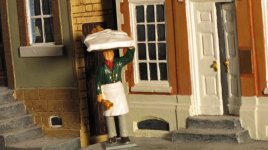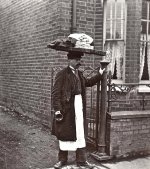jazzeum
Four Star General
- Joined
- Apr 23, 2005
- Messages
- 38,386
Do you know the muffin man,
The muffin man, the muffin man,
Do you know the muffin man,
Who lives in Drury Lane?
Yes, I know the muffin man,
The muffin man, the muffin man,
Yes, I know the muffin man,
Who lives in Drury Lane?



Trophy C 71 Muffins & Crumpets
The “Muffin Man” refers to the delivery of muffins door-to-door probably in the theatre district in London as Drury Lane was the location of the Theatre Royal in London. In the eighteenth century Drury Lane was an over-populated mish-mash of doss houses, brothels, cock pits and gin palaces where gambling, poverty, crime and disease colluded to keep commoners in their place. By the 19[SUP]th[/SUP] Century, the street had degraded further into a filthy hodge-podge of rat-infested lodging houses and tenements housing the very poorest Londoners.Muffins were a cheap and popular foodstuff for the poorer residents of England’s cities in the early nineteenth-century. The muffin man would be seen in his long apron and his stock on a tray atop his head or around his neck hawking his wares in the street.
“Do You Know the Muffin Man” was printed in an 1820 British manuscript (now housed in the Bodleian Library) although its origins may go back to Elizabethan England.

A Muffin Man, circa 1910.
The muffin man, the muffin man,
Do you know the muffin man,
Who lives in Drury Lane?
Yes, I know the muffin man,
The muffin man, the muffin man,
Yes, I know the muffin man,
Who lives in Drury Lane?



Trophy C 71 Muffins & Crumpets
The “Muffin Man” refers to the delivery of muffins door-to-door probably in the theatre district in London as Drury Lane was the location of the Theatre Royal in London. In the eighteenth century Drury Lane was an over-populated mish-mash of doss houses, brothels, cock pits and gin palaces where gambling, poverty, crime and disease colluded to keep commoners in their place. By the 19[SUP]th[/SUP] Century, the street had degraded further into a filthy hodge-podge of rat-infested lodging houses and tenements housing the very poorest Londoners.Muffins were a cheap and popular foodstuff for the poorer residents of England’s cities in the early nineteenth-century. The muffin man would be seen in his long apron and his stock on a tray atop his head or around his neck hawking his wares in the street.
“Do You Know the Muffin Man” was printed in an 1820 British manuscript (now housed in the Bodleian Library) although its origins may go back to Elizabethan England.

A Muffin Man, circa 1910.

